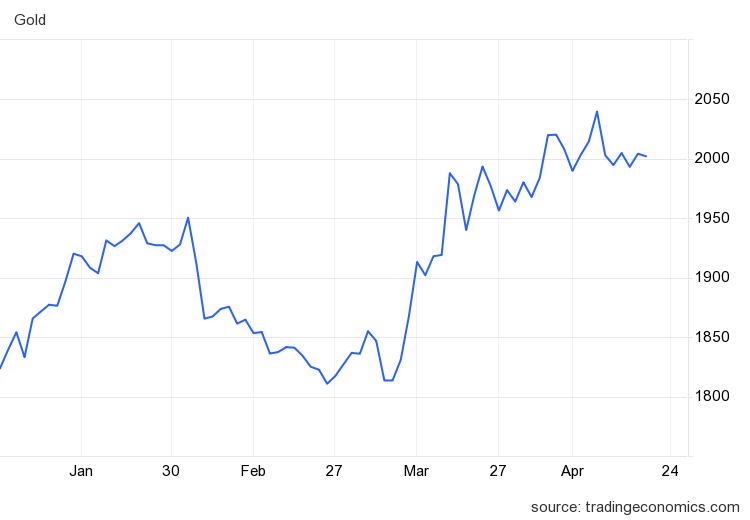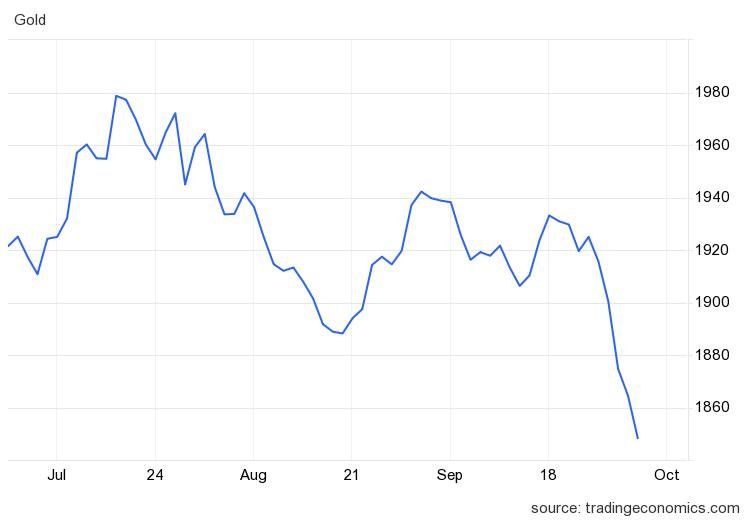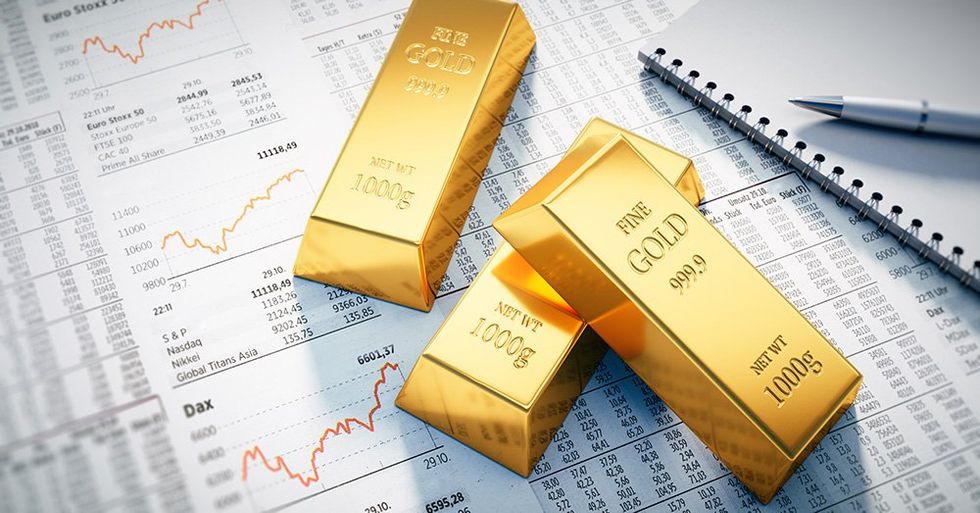Table of Contents:
|
A Sneak Peek At What The Insiders Are Saying
 | “When gold turns, it can turn very, very dramatically, this time in particular because so many people are underinvested in gold and gold stocks.” — Adrian Day, Adrian Day Asset Management |
 | “I do think probably in the first half of 2023, gold and silver and miners are going to put in what I think is going to be a major bottom — a supercycle bottom that’s going to lead to a multi-year rally.” — Chris Vermeulen, TheTechnicalTraders.com |
 | “Gold is in a bull market in every currency in the world except the US dollar.” — Rick Rule, Rule Investment Media |
Who We Are
The Investing News Network is a growing network of authoritative publications delivering independent,
unbiased news and education for investors. We deliver knowledgeable, carefully curated coverage of a variety
of markets including gold, cannabis, biotech and many others. This means you read nothing but the best from
the entire world of investing advice, and never have to waste your valuable time doing hours, days or weeks
of research yourself.
At the same time, not a single word of the content we choose for you is paid for by any company or
investment advisor: We choose our content based solely on its informational and educational value to you,
the investor.
So if you are looking for a way to diversify your portfolio amidst political and financial instability, this
is the place to start. Right now.

Gold Price Update: Q1 2023 in Review
Gold has seen a thunderous start to 2023 — thanks to significant economic disruptions, it’s jumped in value while continuing to play a key role as a safe haven.
The precious metal’s run has created tremendous opportunities for gold bulls, especially as it appears to be stabilizing above the US$2,000 per ounce mark, with experts pointing to potentially higher points this year.
Here the Investing News Network (INN) provides a recap of what happened in the gold market in the first three months of 2023.
Narrative changing after disappointing 2022
Greg Taylor, chief investment officer at Purpose Investments, told INN that many investors were disappointed with gold last year due to its flat performance, even with high levels of inflation.
“(Investors) just got really frustrated with it and it hadn’t really worked. Now it’s starting to work and people are taking another look at it,” Taylor said.
The expert added that since the US dollar was up and enjoyed a strong period last year, it “offset a lot of the inflation reasons for people to own gold.”
But heading into this year, Taylor said, the gold investment cycle has seen new life.
The financial expert explained that even as central banks prepare to pause or slow the pace of their rate hikes, inflation remains higher than they would like.
“We’re starting to hear more and more concerns that there’s potential stagflation,” Taylor said. “When you get stagflation, that’s the perfect snare for gold.”
More investors appreciating gold in 2023
Shree Kargutkar, managing partner at Sprott (TSX:SII,NYSE:SII), told INN that despite gold’s success so far in 2023, he still doesn’t think most investors have exposure to the yellow metal.
“I would say the average investor today is not really invested in gold. Rather, the average investor today is a speculator as far as the bullion is concerned,” Kargutkar said.
The Sprott expert explained that holdings in precious metals bullion exchange-traded funds have declined approximately 15 percent from their peak in the second half of 2020.
“People have actually been reducing their allocation to gold. And the average investor has been spectating for admission,” Kargutkar said.
When discussing the role of gold in an investor’s portfolio, Taylor cautioned that he doesn’t think gold should take a dominant role. “But having a sleeve of real asset exposure in the 5 to 10 percent range is probably not a bad, bad percentage to look at,” he said.
For his part, Kargutkar said the recent move in gold could create a bigger spotlight for the asset class. “My guess is it will probably make people want to perhaps take a second look at the metal as an important constituent of a portfolio,” he said.
US banking crisis boosts gold’s safe-haven appeal
Gold’s tremendous rise can be attributed to a variety of factors in the global economic spectrum, but a major driver has been the fallout from US banking issues.
Silicon Valley Bank and Signature Bank faced serious bank runs after losing the confidence of their users, leading to two of the biggest bank collapses in US history.
This chaos was accompanied by the emergency rescue acquisition of Credit Suisse (NYSE:CS) by UBS (NYSE:UBS), which was in part organized by Swiss authorities.
The pressure points these events created caused panic to settle into the economic landscape, allowing gold to fulfill its role as a safe haven for the investing class.
Gold first crossed the US$2,000 level in March, and has found some stability above the coveted price mark.

Gold price chart, January 1, 2023, to April 20, 2023.
Chart via Trading Economics.
Market watchers eyeing the Fed’s next move
Aside from banking issues, gold continues to be affected by moves from the US Federal Reserve.
Following its meeting in March, the central bank announced a 25 basis point rate hike, saying it remains committed to its goal of curbing inflation. Investors are now watching closely to see what it will do at its next meeting in May.
Economists polled by Reuters are expecting to see another 25 basis point interest rate increase from the central bank, despite recent data points from the consumer price index and the producer price index.
Both price markers show inflationary pressures are easing — in fact, the March drop in the producer price index was the biggest decline since the start of the pandemic in early 2020. Even so, inflation is still far from the Fed’s target of 2 percent.
At the same time, the Fed may not be able to hike much further. Its latest meeting minutes indicate that it expects a “mild recession” in the second half of 2023, spurred by the banking crisis outlined earlier.
“Given their assessment of the potential economic effects of the recent banking-sector developments, the staff’s projection at the time of the March meeting included a mild recession starting later this year, with a recovery over the subsequent two years,” the central bank states in its meeting recap.
The Fed’s next meeting runs from May 2 to 3.
Investor takeaway
After what many deemed a weaker year for gold in 2022, 2023 has been incredibly bullish for the precious metal.
EY’s Theo Yameogo told INN it’s important to remember the nature of the market, and how these jumps have come and gone in the past. “It’s just a reminder that this is cyclical,” he said.
Don’t forget to follow us @INN_Resource for real-time updates!
Securities Disclosure: I, Bryan Mc Govern, hold no direct investment interest in any company mentioned in this article.
Editorial Disclosure: The Investing News Network does not guarantee the accuracy or thoroughness of the information reported in the interviews it conducts. The opinions expressed in these interviews do not reflect the opinions of the Investing News Network and do not constitute investment advice. All readers are encouraged to perform their own due diligence.
Additional information on Gold stock investing — FREE
Gold Price Update: Q2 2023 in Review
Gold remained at historically high levels in the second quarter, although it fell below US$2,000 per ounce.
The US Federal Reserve was in focus during Q2, with investors closely watching the American economy for hints on the central bank’s next move. While the summer is often a slower time, some experts believe it’s a good chance to position.
Here the Investing News Network (INN) presents a recap of the Q2 period for the gold market.
How did the gold price perform in Q2?
The gold price spent a decent amount of time above US$2,000 in Q2, but has since pulled back.
The yellow metal remained near or above that level through April and May, but in June its price strength began to decline. It finished the second quarter around US$1,920, although by mid-July it was back up around US$1,970.

Gold price chart, January 1, 2023, to July 20, 2023.
Chart via Trading Economics.
Actions from the US Federal Reserve continue to impact gold, and at its June meeting it left interest rates unchanged at 5 to 5.25 percent. The decision came after 10 consecutive increases from the central bank.
Fed officials have said the goal is to take time to review the effects of its aggressive hiking strategy.
Since the June meeting, experts have been debating what the Fed will do next. While some market watchers are surprised the Fed has been able to raise rates as far as it has and don’t think it will be able to go much further, the latest “dot plot” projections from Fed officials tell another story — they show two more hikes of 25 basis points each are possible in 2023.
In the gold space, there’s a broad consensus that a change in tactics from the Fed could provide a price boost.
As part of its half-year update, the World Gold Council said global economies appear to be nearing the end of their tightening cycles. “As monetary policy likely transitions from tightening to on-hold, market consensus is for a mild contraction in the US this year, and slow growth in developed markets,” the organization states in its report.
“In this context and following gold’s positive returns in H1, we expect gold to remain supported on the back of range bound bond yields and a weaker dollar,” the World Gold Council also notes.
According to the association, gold has been one of the only true positive investment assets so far in 2023, especially as the economy was hit with uncertainty in North America from several staggering bank runs.
Gold ETF inflow streak ends in June
In another report, the World Gold Council states that June brought the end of a three month streak for inflows into gold-backed exchange-traded funds (ETFs), which are often seen as a safer way to get exposure to the market.
Gold ETFs saw outflows of US$3.7 billion in June, concentrated in Europe and in North America.
“The early June strong equity market performance in key markets likely shifted focus away from risk-off assets such as gold,” the World Global Council said, noting that global gold ETF holdings fell 56 metric tons to 3,422 metric tons.
“And the majority of outflows occurred when the gold price dropped during the second half of the month amid hawkishness from major central banks in the face of obstinate inflationary pressure.”
Summer offers gold investors time to position
John Feneck, portfolio manager and consultant at Feneck Consulting, recently told INN that investors should take advantage of the summer doldrum months to better position themselves in the gold space.
“Summertime and in December as well, when people aren’t doing their homework, is when we’re doing most of our work, because this is when you can pick up some huge bargains. If you feel like doing something with them and disposing of them later next year or the year after, you’re going to make some considerable money we think,” he said.
Watch the full interview with Feneck above.
Investor takeaway
The Q2 period offered a bit of a stopping point for gold as the Fed broke off from its rate hike strategy. Now investors are looking ahead at the second half of the year for catalysts that could push it above US$2,000 once again.
Don’t forget to follow us @INN_Resource for real-time updates!
Securities Disclosure: I, Bryan Mc Govern, hold no direct investment interest in any company mentioned in this article.
Editorial Disclosure: The Investing News Network does not guarantee the accuracy or thoroughness of the information reported in the interviews it conducts. The opinions expressed in these interviews do not reflect the opinions of the Investing News Network and do not constitute investment advice. All readers are encouraged to perform their own due diligence.
Additional information on Gold stock investing — FREE
Gold Price Update: Q3 2023 in Review
The gold price began Q3 on a relatively high note, but was approaching US$1,800 per ounce by its end.
The yellow metal was pushing back toward the US$2,000 mark at the start of the period, but wasn’t able to maintain that level. The quarter culminated in a precipitous decline that saw gold break through support.
What has caused gold to retreat so quickly? Read on to learn more about what factors have affected its price over the last three months, and about significant gold-related news released during that time.
How did the gold price perform in Q3?
Gold tends to underperform in when interest rates are high, which was the case in Q3. At its July meeting, the US Federal Reserve raised rates for the 11th time since March 2022, adding 25 basis points for a range of 5.25 to 5.5 percent — the highest in 22 years. The gold price fell steadily in the two weeks after the decision, slumping to US$1,885.70 on August 17.

Gold price chart, Q3 2023.
Chart via TradingEconomics.com.
After seeing some support from mid-August to mid-September, gold went into a tailspin to close the quarter at US$1,848.80. The drop came as the Fed announced on September 20 that it would hold rates steady, and as Chair Jerome Powell suggested the central bank is in a good position to deliver a “soft enough” landing.
Central banks continue buying gold
While higher rates continued to put pressure on gold this past quarter, global central bank buying has helped maintain the precious metal’s price level. July and August saw central banks pick up 55 metric tons (MT) and 77 MT of gold respectively, bringing the total to 219 MT for the three months ended in August.
Leading the way is China, which has purchased 155 MT of the yellow metal since the start of the year as it tries to minimize its US dollar exposure. Its central bank currently holds gold reserves of 2,165 MT, accounting for 4 percent of global reserves.
With the Russia-Ukraine war on its doorstep, Poland has also been a significant buyer of gold, adding another 18 MT in August and bringing its yearly total to 88 MT. That moves it closer to its intended buying target of 100 MT for the year.
BRICS meeting turns head
Sanctions imposed on Russia following its invasion of Ukraine in February 2022 have renewed the BRICS nations’ interest in finding an alternative to the US dollar as the global reserve currency.
Member nations Brazil, Russia, India and South Africa are keen to break from the US dollar, but it’s China in particular that has been working for several years to establish its own currency as an alternative, with increasing uptake. When the BRICS countries met from August 22 to 24, some market participants believed they might announce a new BRICS currency — perhaps one backed by gold or another commodity. But ultimately no such announcement was made at the meeting.
Many analysts believe the idea is untenable unless China and India are able to find common ground and resolve long-standing differences — and even if they did so, a BRICS currency wouldn’t necessarily be backed by gold.
“The lack of information out there is extremely important in understanding what you’re looking at. There’s a lack of information because there is a lack of development,” Jeffrey Christian, managing partner at CPM Group, explained to the Investing News Network (INN) in the lead-up to the BRICS meeting.
“They do see a desire to cooperate among themselves to counter decades of hegemonic activity by the US and to a lesser extent Europe,” he continued. “But the idea of a central currency makes no sense. None of the countries really want to tie their currencies to Russia. The idea of a different currency backed by gold is a non-starter.”
M&A activity makes headlines
The massive deal between gold giants Newmont (TSX:NGT,NYSE:NEM) and Newcrest Mining (ASX:NCM,TSX:NCM) inched closer to completion through the third quarter. The deal, which will see Newmont acquire 100 percent of Newcrest, reached significant milestones as the companies received key approvals from Australia, Japan and Papua New Guinea.
Newmont shareholders met on October 11 to vote, with 96 percent of them voting in favor of the transaction. Newcrest shareholders are set to vote on October 13. Newmont has been trading lower since it announced its intention to acquire Newcrest on February 5, while Newcrest’s share price has reacted more favorably.
Though this may be the biggest gold deal of the year, 2023 continues to be hot and is on track to bring in the highest level of mergers and acquisitions for the mining sector in a decade.
Other notable M&A announcements in the sector during Q3 include the completion of a merger between GCM Mining and Aris Gold on September 26 to create Aris Mining (TSX:ARIS,NYSE:ARMN). The resultant company has operations in Colombia and produced 60,193 ounces of gold in its most recent quarter.
Aside from that, Canada’s Silvercorp Metals (TSX:SVM,NYSEAMERICAN:SVM) announced on August 6 that it has entered into a binding scheme implementation deed to acquire Australia’s OreCorp (ASX:ORR). The acquisition would give Silvercorp a US$630 million market cap and access to OreCorp’s multimillion-ounce Nyanzaga gold project in Northwest Tanzania. The project is expected to produce 240,000 ounces of gold per year once complete.
David Erfle, editor and founder of Junior Miner Junky, told INN at the end of Q3 that he sees growth potential in gold stocks, but with limited interest from retail investors, more M&A activity is necessary to bring interest to the market.
“A lot of (companies) are at the feasibility stage, or the construction stage or the finance stage, and their market cap is two or three or sometimes four times less than the equity it would take to build the mine,” he said. “What I’d like to see is several of these companies merge, so you have one company with a handful of these projects — maybe $150 million, $200 million in the bank, access to capital and also tack on a big board US listing. Then you’re more liquid, you’re more attractive.”
Biggest IPO of the year is golden
July 7 brought Indonesia’s biggest initial public offering (IPO) this year and one of the world’s best-performing IPOs so far in 2023: PT Amman Mineral Internasional (IDX:AMMN). The company raised the equivalent of over US$713 million in its IPO, and shares have since surged 250 percent in value, giving the firm a market cap of US$29 billion.
The company’s most significant asset, Amman Mineral Nusa Tenggara — which includes the Batu Hijau mine, the second largest gold mine in Indonesia — was purchased from Newmont in 2016. The copper-gold mine produced 172,000 ounces of the yellow metal during the first half of the year.
So, why has gold retreated?
Even though there have been strong gold sector developments over the past three months, larger economic trends have made investments like Treasuries more attractive and have dulled gold’s luster. The yellow metal’s relatively flat growth over the past few years has also prompted investors to look for more immediate gains elsewhere.
With the US economy and dollar staying strong and no relief from high interest rates until at least 2024, it’s not looking good for investors who hope gold will break through US$2,000 in the coming months.
However, the Fed has indicated that it’s tracking the economy closely and has acknowledged that a recession hasn’t been completely avoided. The central bank will meet again from October 31 to November 1 to determine whether another hike will be needed and to outline its steps for the beginning of next year.
Investor takeaway
Following a solid start to the year for gold, the third quarter brought setbacks for the metal, which is subject to both broad market forces and investor appetites. While retail and institutional investors may continue to shy away from gold for interest-bearing assets, central bank buying looks set to persist and may be a factor in price stabilization in Q4.
At the same time, Q4 has already brought a great deal of geopolitical instability. The invasion of Ukraine remains an issue for investors and, if it worsens, it could push the price of gold higher. Additionally, a burgeoning conflict in Israel has already pushed the price of the yellow metal up nearly 1 percent since hostilities began on October 7.
Don’t forget to follow us @INN_Resource for real-time updates!
Securities Disclosure: I, Dean Belder, hold no direct investment interest in any company mentioned in this article.
Editorial Disclosure: The Investing News Network does not guarantee the accuracy or thoroughness of the information reported in the interviews it conducts. The opinions expressed in these interviews do not reflect the opinions of the Investing News Network and do not constitute investment advice. All readers are encouraged to perform their own due diligence.
Additional information on Gold stock investing — FREE
Lobo Tiggre: Gold Stocks are My Highest-Conviction Trade for 2024
In a recent interview, Lobo Tiggre, editor and founder of IndependentSpeculator.com, shared his highest-conviction trade for 2024. While he’s still a uranium bull, he sees the most opportunity in gold stocks next year.
Back in July, Tiggre’s focus had narrowed to uranium and he was feeling bearish on gold in the near term. But now he sees various factors lining up for gold, including a US recession, geopolitical concerns, inflation and central bank buying.
“Maybe it means a little bit more for me to say I’m looking at (gold),” he told the Investing News Network. “I’m looking at the recession — it’s here on a global level and I think it’s here in disguise in the US. But I think the disguise falls.”
Watch the interview above for more from Tiggre on gold, as well as uranium and silver. You can also click here for the Investing News Network’s full New Orleans Investment Conference playlist on YouTube.
Don’t forget to follow us @INN_Resource for real-time updates!
Securities Disclosure: I, Charlotte McLeod, hold no direct investment interest in any company mentioned in this article.
Editorial Disclosure: The Investing News Network does not guarantee the accuracy or thoroughness of the information reported in the interviews it conducts. The opinions expressed in these interviews do not reflect the opinions of the Investing News Network and do not constitute investment advice. All readers are encouraged to perform their own due diligence.
Additional information on Gold stock investing — FREE
Tavi Costa: Gold Price Breakout is “Inevitable,” Don’t Lose Focus Now
Speaking at the New Orleans Investment Conference, Tavi Costa, partner and portfolio manager at Crescat Capital, discussed sentiment in the resource sector, including where he sees opportunity today.
“Everyone is sort of waiting for this breakout in gold, otherwise there’s no party,” he said on the sidelines of the event. “Everyone is just waiting patiently, and in my view it’s going to happen — it’s inevitable that we’re going to see a breakout. Then other commodities should follow, and then the valuations of companies should be rerated.”
In terms of timing, Costa said that back in 2018 he started looking closely at CAPEX trends among mining companies. “You can kind of see when that bottoms out you tend to see a bull market in commodities. You just don’t know on the macro side what the trigger is going to be, but the foundation of the thesis is there,” he explained.
“I feel like everything is really coming together right now, (but) the sentiment is really bearish,” Costa continued. “I am not that way at all. I’m extremely bullish, I’m really focused right now … you don’t want to lose focus at the wrong time.”
Moving forward, he expects to see the traditional 60/40 portfolio fall by the wayside. “Those two allocations need to be redefined,” he said. “I think commodities are going to play a role there. I think gold is going to be one of those assets that is going to be competing with Treasuries, just like central banks have been changing their allocation.” Notably, he pointed out that recent research shows 70 percent of advisors have portfolios with less than 1 percent gold.
“I think (gold is) going to be one side. And then a basket of commodities will probably take the other side. And I would say emerging markets, especially rich resource economies like Brazil, will probably take a part of the equity market portion.”
Watch the interview above for more of Costa’s thoughts on gold and the resource sector. You can also click here for the Investing News Network’s full New Orleans Investment Conference playlist on YouTube.
Don’t forget to follow us @INN_Resource for real-time updates!
Securities Disclosure: I, Charlotte McLeod, hold no direct investment interest in any company mentioned in this article.
Editorial Disclosure: The Investing News Network does not guarantee the accuracy or thoroughness of the information reported in the interviews it conducts. The opinions expressed in these interviews do not reflect the opinions of the Investing News Network and do not constitute investment advice. All readers are encouraged to perform their own due diligence.
Additional information on Gold stock investing — FREE
Top 10 Gold-mining Companies
Regardless of how the gold price is doing in any given year, the top gold-mining companies are always making moves.
Right now, the yellow metal is in the limelight — stimulated by increasing global inflation, geopolitical turmoil and recession fears, the price of gold has broken past the US$2,000 per ounce level multiple times in 2023.
Rising demand for gold alongside concerns over gold mine supply have pushed the metal to record highs in recent years, and market watchers are eyeing world’s top gold-mining companies to see how they respond to current market dynamics.
According to the most recent US Geological Survey data, gold production increased by approximately 2 percent in 2021, and by a mere 0.32 percent in 2022. China, Australia and Russia were the top three countries to produce gold last year.
But what were the top gold-mining companies by production in 2022? The list below was compiled by the team at Refinitiv, a leading financial markets data provider. Read on to find out which companies produced the most gold last year.
1. Newmont (TSX:NGT,NYSE:NEM)
Company Profile
Production: 185.3 MT
Newmont was the largest of the top gold-mining companies in 2022. The firm holds significant operations in North and South America, as well as Asia, Australia and Africa. Newmont produced 185.3 metric tons (MT) of gold in 2022.
In early 2019, the miner acquired Goldcorp in a US$10 billion deal; it followed that up by starting a joint venture with Barrick Gold (TSX:ABX,NYSE:GOLD) called Nevada Gold Mines; is 38.5 percent owned by Newmont and 61.5 percent owned by Barrick, which is also the operator. Considered the world’s biggest gold complex, Nevada Gold Mines was the top-producing gold operation in 2022 with output of 94.2 MT.
Newmont’s gold production guidance for 2023 is set at 5.7 million to 6.3 million ounces (161.59 to 178.6 MT).
2. Barrick Gold (TSX:ABX,NYSE:GOLD)
Company Profile
Production: 128.8 MT
Barrick Gold lands in second place on this list of top gold producers. The company has been active on the M&A front in the last five years — in addition to merging its Nevada assets with Newmont in 2019, the company closed its acquisition of Randgold Resources the prior year.
Nevada Gold Mines is not Barrick’s only asset that is a top-producing gold operation. The major gold company also holds the Pueblo Viejo mine in the Dominican Republican and the Loulo-Gounkoto mine in Mali, which produced 22.2 MT and 21.3 MT, respectively, of the yellow metal in 2022.
In its annual report for 2022, Barrick notes that its full-year gold production was slightly less than its stated guidance for the year, rising a little over 7 percent from the previous year’s level. The company has attributed this shortfall to lower production at Turquoise Ridge due to unplanned maintenance events, and at Hemlo due to the temporary water inflows that impacted mining productivity. Barrick has set its 2023 production guidance at 4.2 million to 4.6 million ounces (119.1 to 130.4 MT).
3 Agnico Eagle Mines (TSX:AEM,NYSE:AEM)
Company Profile
Production: 97.5 MT
Agnico Eagle Mines produced 97.5 MT of gold in 2022 to take the third spot on this top 10 gold companies list. The company has 11 operating mines in Canada, Australia, Finland and Mexico, including 100 percent ownership of two of the world’s top gold-producing mines — the Canadian Malartic mine in Quebec and the Detour Lake mine in Ontario — which it acquired from Yamana Gold (TSX:YRI,NYSE:AUY) in early 2023.
The Canadian gold miner achieved record annual production in 2022, and also increased its gold mineral reserves by 9 percent to 48.7 million ounces of gold (1.19 million MT grading 1.28 grams per MT gold). Its gold production for 2023 is expected to reach 3.24 million to 3.44 million ounces (91.8 to 97.5 MT). Based on its near-term expansion plans, Agnico Eagle is forecasting production levels of 3.4 million to 3.6 million ounces (96.4 to 102.05 MT) in 2025.
4. AngloGold Ashanti (NYSE:AU,ASX:AGG)
Company Profile
Production: 85.3 MT
Coming in fourth on this top gold-mining companies list is AngloGold Ashanti, which produced 85.3 MT of gold in 2022. The South African company has nine gold operations in seven countries across three continents, as well as numerous exploration projects around the world. AngloGold’s Kibali gold mine (a joint venture with Barrick as the operator) in the Democratic Republic of Congo is the fifth largest gold mine in the world, having produced 23.3 MT of gold in 2022.
In 2022, the company increased its gold production by 11 percent over 2021, coming in at the top end of its guidance for the year. Its production guidance for 2023 is set at 2.45 million to 2.61 million ounces (69.46 to 74 MT).
5. Polyus (LSE:PLZL,MCX:PLZL)
Company Profile
Production: 79 MT
Polyus produced 79 MT of gold in 2022 to take fifth place among the top 10 gold-mining companies. It is the largest gold producer in Russia and holds the highest proven and probable gold reserves globally at more than 101 million ounces.
Polyus has six operating mines located in Eastern Siberia and the Russian Far East, including Olimpiada, which ranks as the world’s third largest gold mine by production. The company expects to produce approximately 2.8 million to 2.9 million ounces (79.37 to 82.21 MT) of gold in 2023.
6. Gold Fields (NYSE:GFI)
Company Profile
Production: 74.6 MT
Gold Fields comes in at number six for 2022 with gold production for the year totaling 74.6 MT. The company is a globally diversified gold producer with nine operating mines in Australia, Chile, Peru, West Africa and South Africa.
Gold Fields and AngloGold Ashanti recently joined forces to combine their Ghana exploration holdings and create what the companies claim will be Africa’s biggest gold mine. The joint venture has the potential to produce an annual average of 900,000 ounces (or 25.51 MT) of gold over the first five years.
The company’s production guidance for 2023 is in the range of 2.25 million to 2.3 million ounces (63.79 to 65.2 MT). This figure excludes production from Gold Fields’ Asanko joint venture in Ghana.
7. Kinross Gold (TSX:K,NYSE:KGC)
Company Profile
Production: 68.4 MT
Kinross Gold has six mining operations across the Americas (Brazil, Chile, Canada and the US) and East Africa (Mauritania). Its largest producing mines are the Tasiast gold mine in Mauritania and the Paracatu gold mine in Brazil.
In 2022, Kinross produced 68.4 MT of gold, which was a 35 percent year-on-year increase from its 2021 production level. The company attributed this increase to the restart and ramp-up of production at the La Coipa mine in Chile, as well as to higher production at Tasiast after the resumption of milling operations that were temporarily suspended in the prior year.
8. Newcrest Mining (TSX:NCM,ASX:NCM)
Company Profile
Production: 67.3 MT
Newcrest Mining produced 67.3 MT of gold in 2022. The Australian company operates a total of five mines across Australia, Papua New Guinea and Canada. Its Lihir gold mine in Papua New Guinea is the world’s seventh largest gold mine by production.
According to Newcrest, it has one of the largest group gold ore reserves in the world. With an estimated 52 million ounces of gold ore reserves, its reserve life is approximately 27 years. The number one gold-producing company on this list, Newmont, made a proposal to combine with Newcrest in February; the deal closed successfully in November.
9. Freeport-McMoRan (NYSE:FCX)
Company Profile
Production: 56.3 MT
Better known for its copper production, Freeport-McMoRan produced 56.3 MT of gold in 2022. The vast majority of that production originates from the company’s Grasberg mine in Indonesia, which ranks as the world’s second largest gold mine by production.
In its Q3 results for this year, Freeport-McMoRan states that long-term mine development activities are underway at Grasberg’s Kucing Liar deposit. The company anticipates that the deposit will ultimately produce more than 6 billion pounds of copper and 6 million ounces of gold (or 170.1 MT) between 2028 and the end of 2041.
10. Zijin Mining Group (SHA:601899)
Company Profile
Production: 55.9 MT
Zijin Mining Group rounds out this top 10 gold companies list with production of 55.9 MT of gold in 2022. The company’s diverse metals portfolio includes seven gold-producing assets in China, and several others in gold-rich jurisdictions such as Papua New Guinea and Australia.
In 2023, Zijin presented its revised three year plan through 2025, as well as its 2030 development goals, one of which is to move up the ranks to become a top three to five producer of gold and copper.
Don’t forget to follow us @INN_Resource for real-time news updates!
Securities Disclosure: I, Melissa Pistilli, hold no direct investment interest in any company mentioned in this article.
Additional information on Gold stock investing — FREE
Credit: Source link




